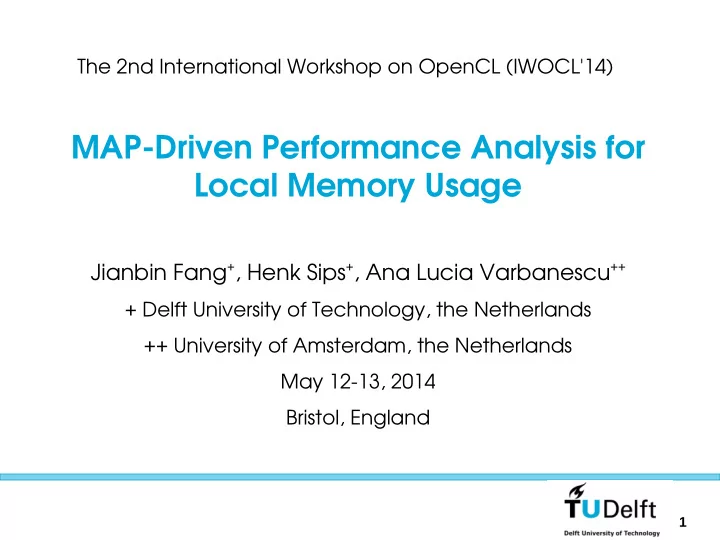

The 2nd International Workshop on OpenCL (IWOCL'14) MAP-Driven Performance Analysis for Local Memory Usage Jianbin Fang + , Henk Sips + , Ana Lucia Varbanescu ++ + Delft University of Technology, the Netherlands ++ University of Amsterdam, the Netherlands May 12-13, 2014 Bristol, England 1
Outline Introducing local memory (background) Our research question (why) Our approach (how) Our key findings (results) 2
OpenCL and Local Memory Like-a-cache: on-chip and faster Not-a-Cache: user-managed Data elements are shared by work-items of a work-group 3
Rules of Thumb Using local memory on GPUs is preferred (e.g., data reuse) Using local memory on CPUs is not recommended 4
The Reality is ... A counter-intuitive example 3x3 convolution On Intel Xeon E5620 (6 cores) Better 16 14 12 Bandwidth (GB/s) 10 8 w/o w/ 6 4 2 0 128x128 256x256 512x512 1024x1024 2048x2048 Dataset 5
The Reality is ... A counter-intuitive example 3x3 convolution On Intel Xeon E5620 (6 cores) Better LM on CPUs ≠ Performance loss 16 14 12 Bandwidth (GB/s) 10 8 w/o w/ 6 4 2 0 128x128 256x256 512x512 1024x1024 2048x2048 Dataset 6
When to Use Local Memory? 7
Our Approach 8
MAP Description OpenCL organizes parallelism at two levels We describe a MAP at two levels eMAP: work-group level iMAP: work-item level iMAP eMAP 9
33 MAP Citizens iMAP eMAP eMAP M00, M01, M10, M11 ∈ {0,1} iMAP Single, Row, Column, Block, Neighbor 10
Micro-Benchmarks We generate 2 micro-benchmarks (in OCL) for each MAP The kernel code Local space allocation Local data staging Local data access (specified by the MAP) We provides a tool (Aristotle*) to facilitate this process *https://github.com/haibo031031/aristotle 11
Experimental Platforms Devices SPM-only: NVIDIA C1060 SPM+Cache: AMD HD7970, NVIDIA C2050, K20 Cache-only: Intel Xeon X5650. E5-2620, Intel Phi 5110P Software environments AMD APP v2.8 Intel OpenCL SDK v3.0 NVIDIA CUDA v5.5 (not updated for long time ) 12
Experimental Setup Metrics: bandwidth Datasets 128, 256, 512, 1024, 2048, 4096 Block MAPs: r=3 Run each measurement for 21 iterations 1 iteration to warm-up Measure 20 iterations Flush caches between iterations 13
A Bird's-eye View Performance gain/loss distribution 100% 90% 80% 70% 60% similar loss 50% gain 40% 30% 20% 10% 0% C1060 C2050 K20 HD7970 Phi-5110p E5-2620 X5650 Devices NVIDIA GPUs AMD GPU Intel CPUs & Phi Datasets: 4096x4096 14
A Bird's-eye View Performance gain/loss distribution 100% 90% 80% 70% 60% similar loss 50% gain 40% 30% 20% 10% 0% C1060 C2050 K20 HD7970 Phi-5110p E5-2620 X5650 Devices NVIDIA GPUs AMD GPU Intel CPUs & Phi Datasets: 4096x4096 15
A Bird's-eye View Performance gain/loss distribution 100% 90% 80% 70% 60% similar loss 50% gain 40% 30% 20% 10% 0% C1060 C2050 K20 HD7970 Phi-5110p E5-2620 X5650 Devices NVIDIA GPUs AMD GPU Intel CPUs & Phi Datasets: 4096x4096 16
A Bird's-eye View Performance gain/loss distribution 100% 90% 80% 70% 60% similar loss 50% gain 40% 30% 20% 10% 0% C1060 C2050 K20 HD7970 Phi-5110p E5-2620 X5650 Devices NVIDIA GPUs AMD GPU Intel CPUs & Phi Datasets: 4096x4096 17
100% 80% SPM Processors 60% 40% 20% 0% C1060 C2050 K20 HD7970 Phi-5110p E5-2620 X5650 Memory bandwidth increase factors Data reuse (A) Changed memory access orders (B) 18
SPM Processors: w/o Caches VS. w/ Caches Better The performance gain canceled Disabling local memory is better MAP-514 w/ LM w/o LM C1060 19 C2050 K20
100% 80% Cache-only Processors 60% 40% 20% 0% C1060 C2050 K20 HD7970 Phi-5110p E5-2620 X5650 Emulating local memory on global memory Using local memory might utilize caches better MAP-302 w/ LM Better w/o LM Phi-5110P E5-2620 X5650 20
Cache-only Processors Using local memory on MAP-302 leads to a BW increase Profile the number of cache-line replacements on E5-2620 Better L1 cache replacement L2 cache replacement 21
Performance Database Use-Scenario 22
Summary Data reuse and access order changes are positive factors Unpredictable local memory performance is due to caches Our query-based approach to decide local memory usage Architecture design indications SPM and caches co-exist !? 23
Follow-up Questions Evaluations on more platforms, e.g., tiny GPUs How to identify MAPs for a given kernel? Visual inspection Automatic tools How to 'predict' the performance impact of using local memory in the presence of multiple MAPs? How to enable/disable local memory usage? Enabler*: w/o → w/ Disabler**: remove the use of local memory *J. Fang, et al., "ELMO: A User-Friendly API to enable local memory in OpenCL kernels," in PDP2013. **J. Fang, et al., "Grover: Looking for Performance Improvement by Disabling Local Memory Usage in OpenCL Kernels," ICPP2014 (in submission). 24
Questions Jianbin Fang PhD student at TU Delft j.fang@tudelft.nl Jianbin Fang Ana Lucia Varbanescu Henk Sips 25
Recommend
More recommend